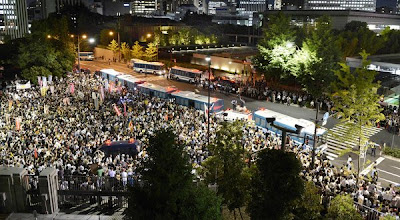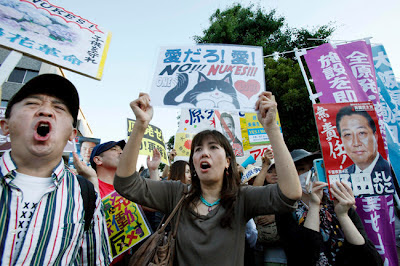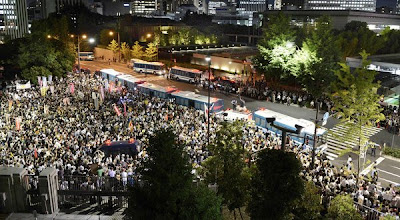NHK reported that there was a demonstration. The coverage, however, was a mere formality. No information on the scale of the demonstration and public anger is available on the NHK news. There is no other way to say that NHK really plays dirty.
Masatoshi Takeshita
* Information from Mr. Takeshita posted on his blog – June 30, 2012
English translation of a Japanese article from “Monju Bosatsu” blog – June 30, 2012
Photo from NY Times
On Friday last week 45,000 people got together for a demonstration, but NHK reported nothing special.
Organizers say that 200,000 people joined in this meeting to protest against the restarting of Ohi power station.
I guess that even NHK was not able to continue ignoring this size of demonstration. However, other Japanese media had not changed a bit.
They never covered such a big scale of demonstration.
Instead they reported that the sister of Mr. Taro Yamamoto, an icon of no-nuke movement, had been arrested on suspicion of violating the Cannabis Control Law (possessing cannabis).
This has demonstrated anew how terribly rotten Japanese mass media is.
In Tokyo, Thousands Protest the Restarting of a Nuclear Power Plant (NY Times)
Reprinted from NY Times
TOKYO ― Shouting antinuclear slogans and beating drums, tens of thousands of demonstrators gathered in front of the prime minister’s residence on Friday, in the largest display yet of public anger at the government’s decision to restart a nuclear power plant.
The crowd, including women with small children and men in suits coming from work, chanted “No more Fukushimas!” as it filled the broad boulevards near the residence and the national Parliament building, which were cordoned off by the police.
Estimates of the crowd’s size varied widely, with organizers claiming 150,000 participants, while the police put the number at 17,000. Local media estimated the crowd at between 20,000 and 45,000, which they described as the largest protest in central Tokyo since the 1960s.
Protests of any size are rare in Japan, which has long been politically apathetic. However, there has been growing discontent among many Japanese who feel that Prime Minister Yoshihiko Noda ignored public concerns about safety this month when he ordered the restarting of the Ohi power station in western Japan.
Ohi was the first plant to go back online since last year’s accident in Fukushima led to the idling of all of Japan’s 50 operational nuclear reactors, which supplied a third of the nation’s electricity. Three reactors at the Fukushima Daiichi plant melted down after a huge earthquake and tsunami knocked out crucial cooling systems.
Mr. Noda said he ordered the restarting of two of Ohi’s reactors to avoid power shortages that could cause blackouts during the sweltering summer and also cripple industry. However, political analysts have warned of a public backlash after opinion polls showed that two-thirds of Japanese opposed the restart, with many saying that the government had failed to persuade them that the plant had been made safe.
On Friday, many of the protesters complained that Mr. Noda was trying to take Japan back to its political business-as-usual of powerful bureaucrats and industry executives making decisions behind closed doors. Some described their outrage over the restart decision as a moment of political awakening, saying they were taking to the streets for the first time.
“Japanese have not spoken out against the national government,” said Yoko Kajiyama, a 29-year-old homemaker who carried her 1-year-old son. “Now, we have to speak out, or the government will endanger us all.”
“To restart the nuclear plant without ensuring its safety is crazy,” said Naomi Yamazaki, 37, another homemaker and first-time demonstrator. “I know we need these plants for power and jobs, but I don’t trust the authorities now to protect us.”
Organizers said a such mistrust has led to a quick growth in the size of the protests, which have been held every week since late March. The protests began with a few hundred participants, but rose into the thousands after Mr. Noda’s restart decision, said one organizer, Misao Redwolf, a illustrator based here in Tokyo.
Tetsunari Iida, director of the Institute for Sustainable Energy Policies, an energy policy group based in Tokyo, said the protests reflected wider discontent toward the government, which many say failed to protect public health after the accident, and then rushed to get the country’s reactors back online.
“There is anger and a loss of confidence in the government,” Mr. Iida said. “This is an irreversible change, and I expect this type of movement to continue.”
For his part, the prime minister seemed unfazed by the protests. “They’re making lots of noise,” Mr. Noda remarked to reporters as he left his office for his private quarters.
While noisy, the protesters on Friday demonstrated Japan’s penchant for being well organized and fastidiously polite. In many places, they kept passages clear for pedestrians and stood in neat lines along sidewalks. When the protest ended at 8 p.m., organizers quickly dispersed participants using megaphones, with hardly a scrap of garbage left behind.
Hiroko Tabuchi contributed reporting.


